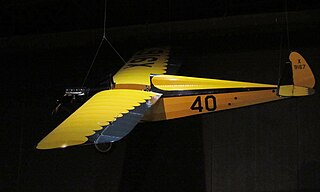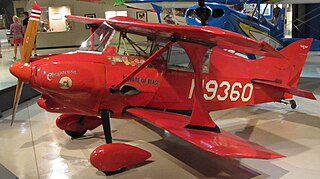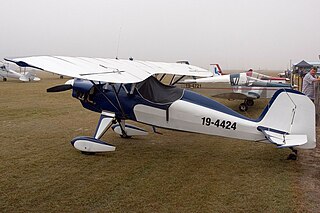
The Ace Baby Ace, a single-seat, single-engine, parasol wing, fixed-gear light airplane, was marketed as a homebuilt aircraft when its plans were first offered for sale in 1929 — one of the first homebuilt aircraft plans available in the United States. Plans are still available and Baby Aces are still being built. Orland Corben designed a series of aircraft for the Ace Aircraft Manufacturing Company, the Baby Ace, Junior Ace, and Super Ace. Corben's name was associated with the aircraft, and it is commonly known as the Corben Baby Ace.

The Ace Junior Ace is a two-seat sports aircraft that has been offered by the Ace Aircraft Manufacturing Company in kit and plans form for home building since the early 1930s. It was designed by Orland Corben.

The Pietenpol Air Camper is a simple parasol wing homebuilt aircraft designed by Bernard H. Pietenpol. The first prototype that became the Air Camper was built and flown by Pietenpol in 1928.

The Evans VP-1 Volksplane is an American designed aircraft for amateur construction. The aircraft was designed by former Convair, Ryan Aircraft and General Dynamics aeronautical engineer William Samuel Evans of La Jolla, California.

The Christen Eagle, which later became the Aviat Eagle in the mid-1990s, is an aerobatic sporting biplane aircraft that has been produced in the United States since the late 1970s.

The Heath Parasol is an American single or two seat, open-cockpit, parasol winged, homebuilt monoplane.
The Iannotta I-66L San Francesco is a 1960s Italian ultralight designed to be homebuilt from plans. It has been powered by several flat-four engines in the 65-100 hp range and built in both single and two-seat tandem configurations. Only small numbers have been completed.

The Church Midwing JC-1, a.k.a. Church Mid-Wing Sport, is a midwing racing aircraft designed by James Church using the fuselage of a Heath aircraft.

The Dormoy Bathtub was a simple-to-construct, high wing racing aircraft of the 1920s.

The P-5 Pober Sport is an early low-wing homebuilt aircraft designed by Experimental Aircraft Association founder Paul Poberezny. The one example built was flown across the country to every EAA chapter at the time.
The Bird Wing or later, Bird Wing Imperial was a light sport biplane of the 1920s and 1930s.

The Hegy "El Chuparosa" is a homebuilt, enclosed-cockpit biplane that was designed in the early 1950s.

The Morane-Saulnier MS.180 is a single engine parasol wing aerobatic trainer aircraft that was designed and produced by the French aircraft manufacturer Morane-Saulnier.
The Sheffield Skeeter X-1 is an American single-seat lightweight homebuilt aircraft designed and built by Kenneth Sheffield of Littleton, Colorado. Designed for amateur construction only the prototype was built.

The Powell P-70 Acey Deucy is an American two-seat parasol wing monoplane designed and built by John C. Powell for amateur construction.

The Aerotique Parasol is an American parasol-wing, strut-braced, conventional landing gear, single-seat, open cockpit, single engine in tractor configuration, ultralight aircraft that was designed as an ultralight version of the 1926 vintage Heath Parasol. It was originally produced by Yesteryear Aviation and later by Aerotique Aviation. The aircraft was supplied as factory-built only.
The Ganagobie is a single place, parasol wing homebuilt aircraft that was built by Willam and James Lobet, first flying in 1953.

The Vulcan American Moth Monoplane was an early parasol-wing monoplane developed by the Doyle brothers.

The Stolp SA-500 Starlet is an American amateur-built aircraft. The aircraft is supplied in the form of plans for amateur construction by Aircraft Spruce & Specialty of Corona, California.
The Wier RDW-2 Draggin' Fly was a homebuilt light aircraft, designed in the United States in the 1970s, aimed at fairly inexperienced builders and flyers. Plans were available but only one was built.















